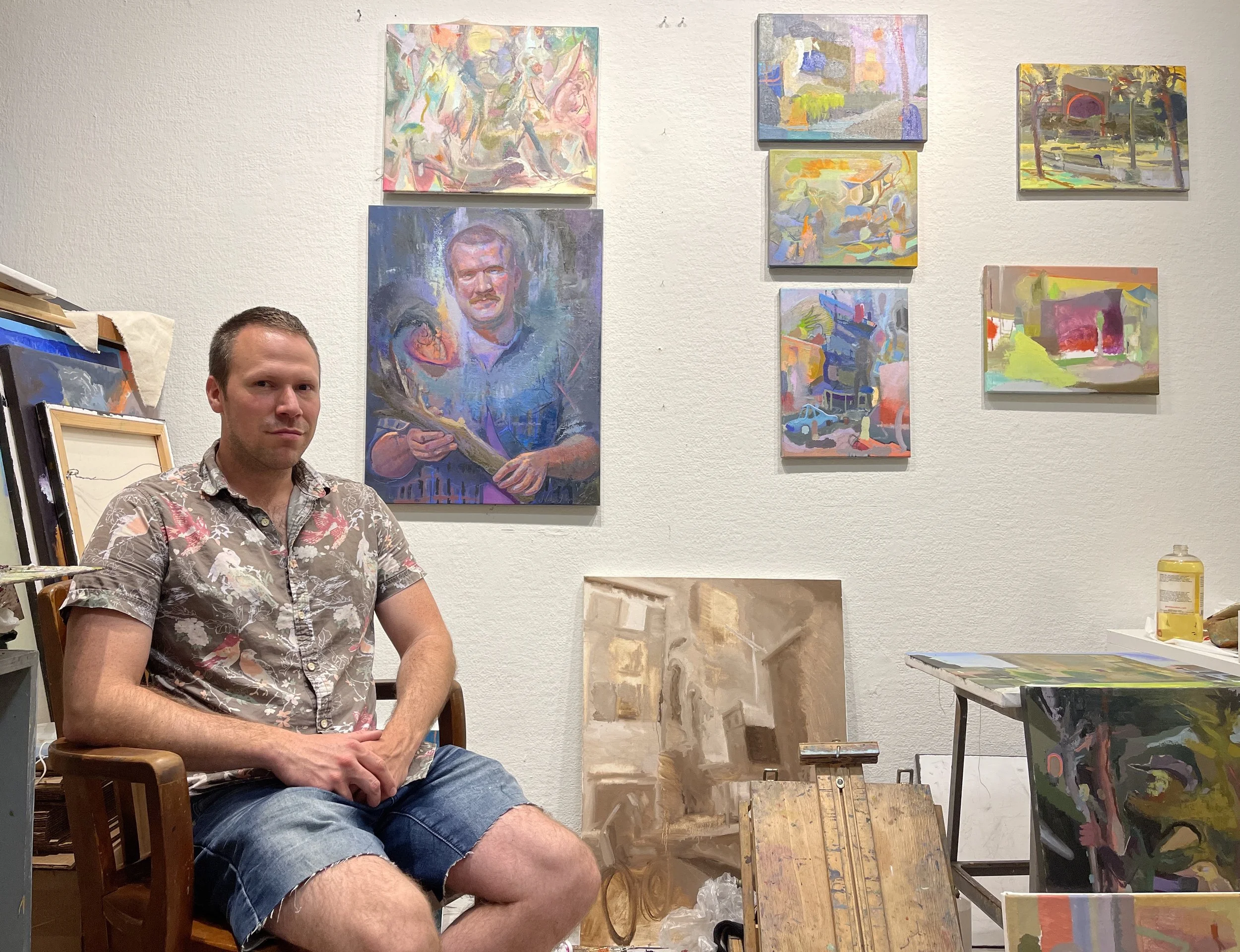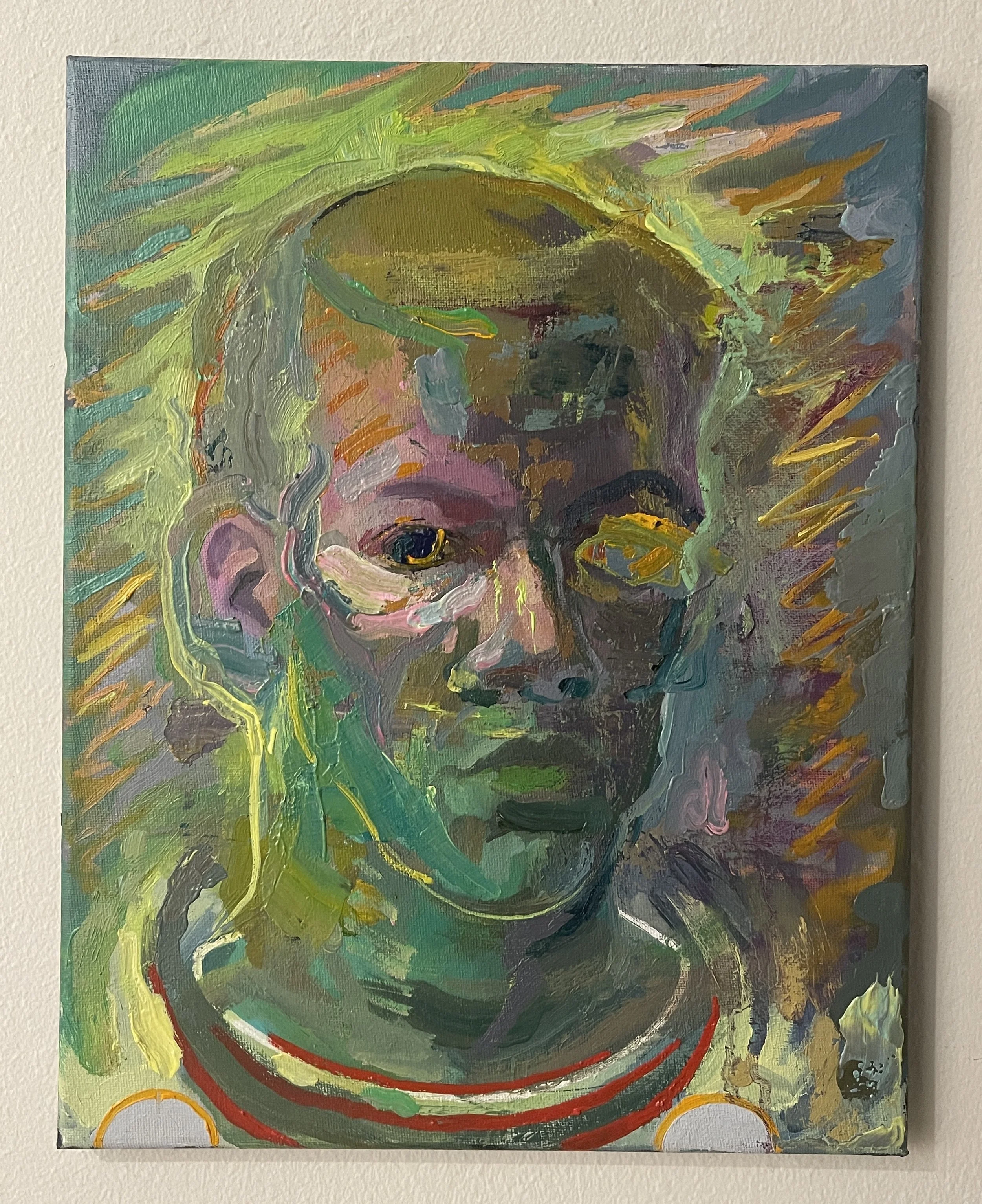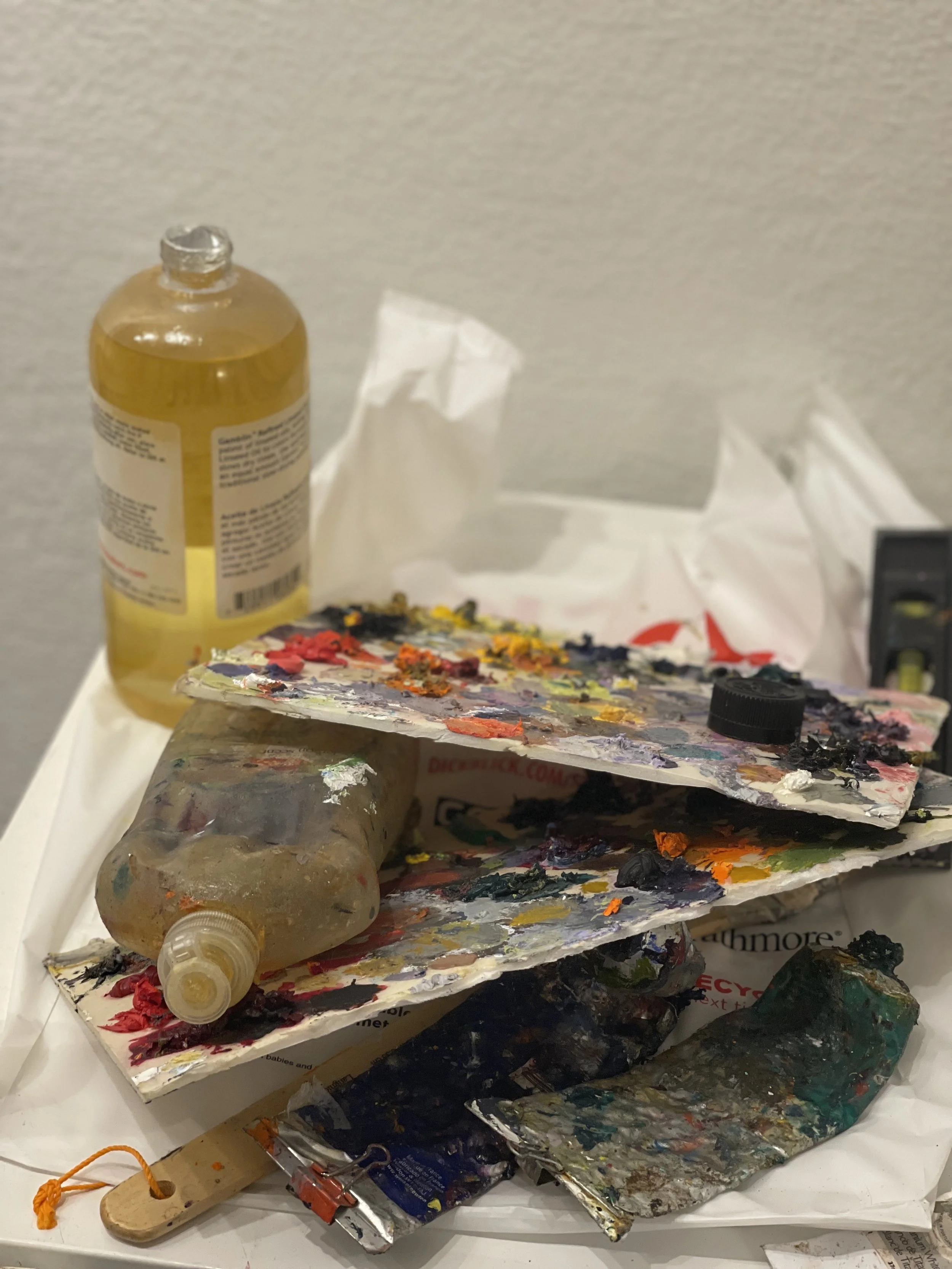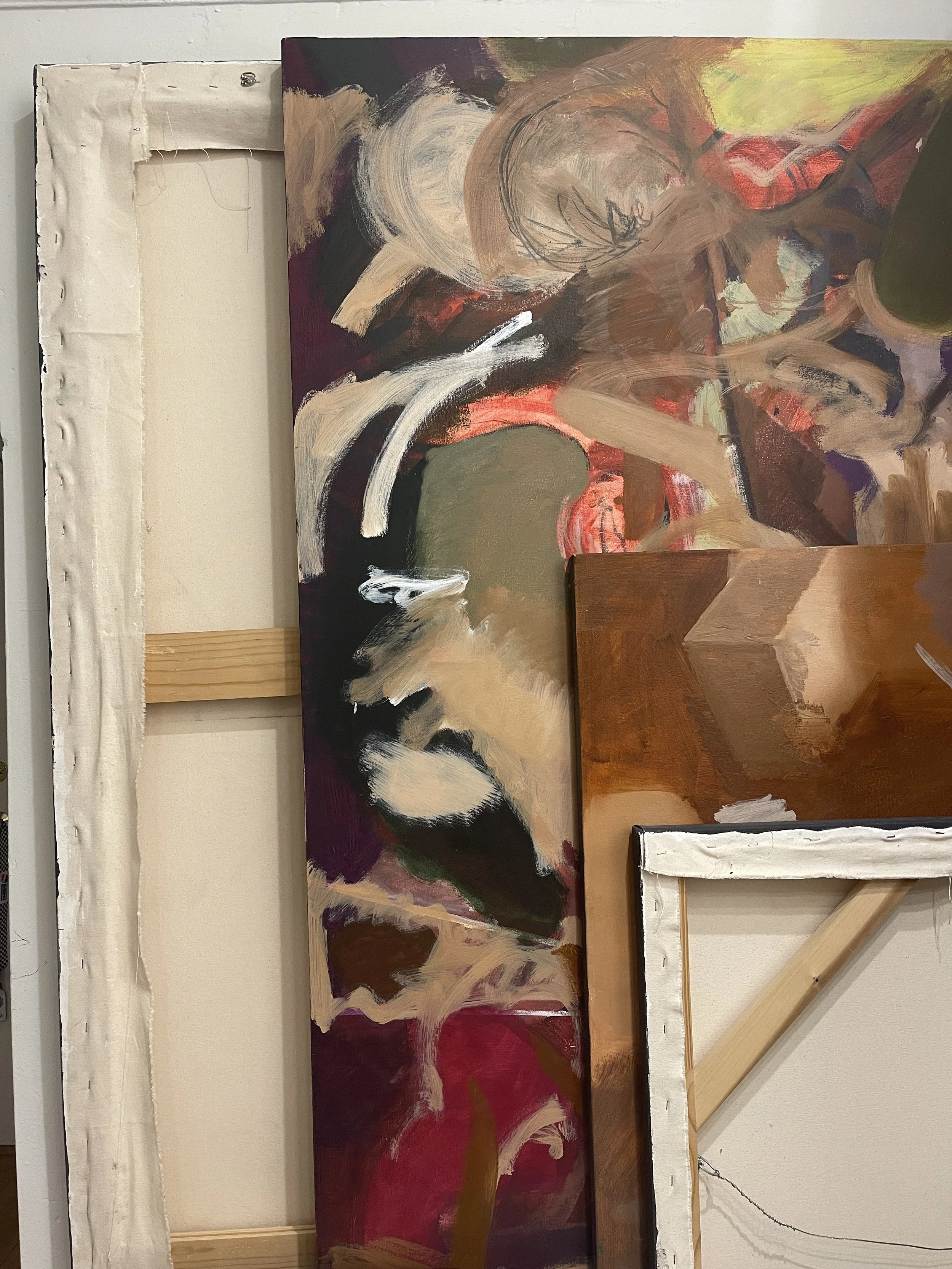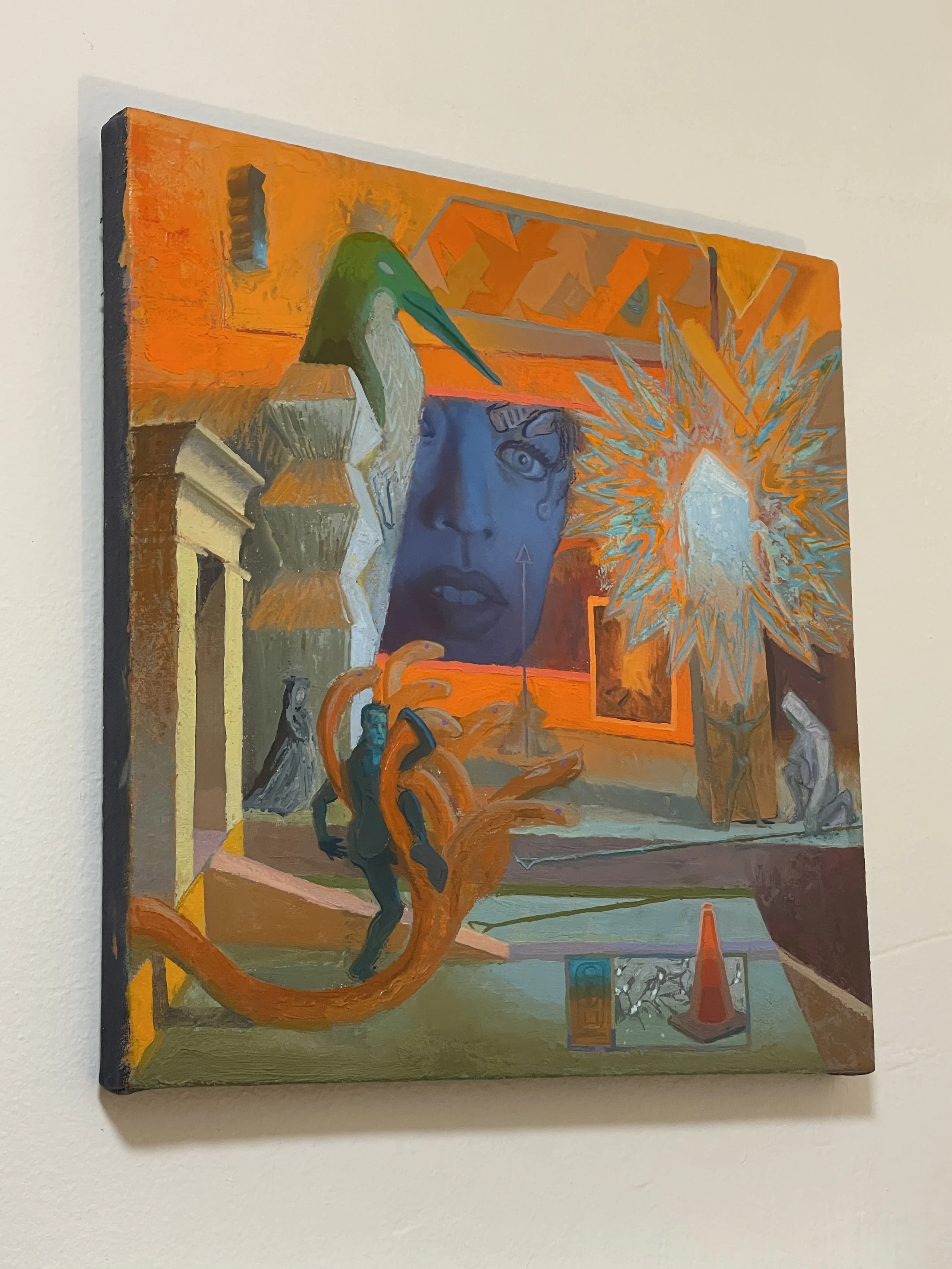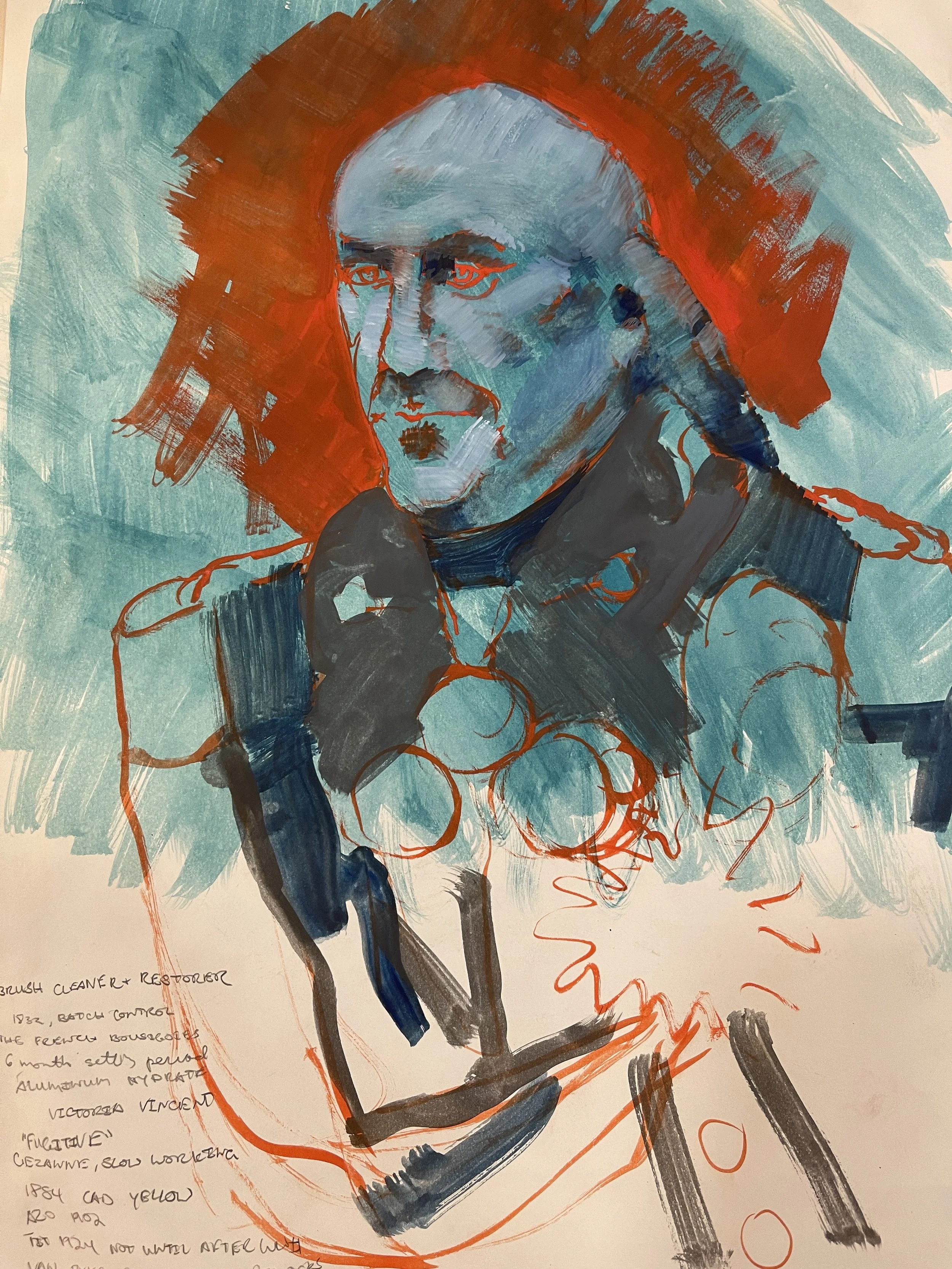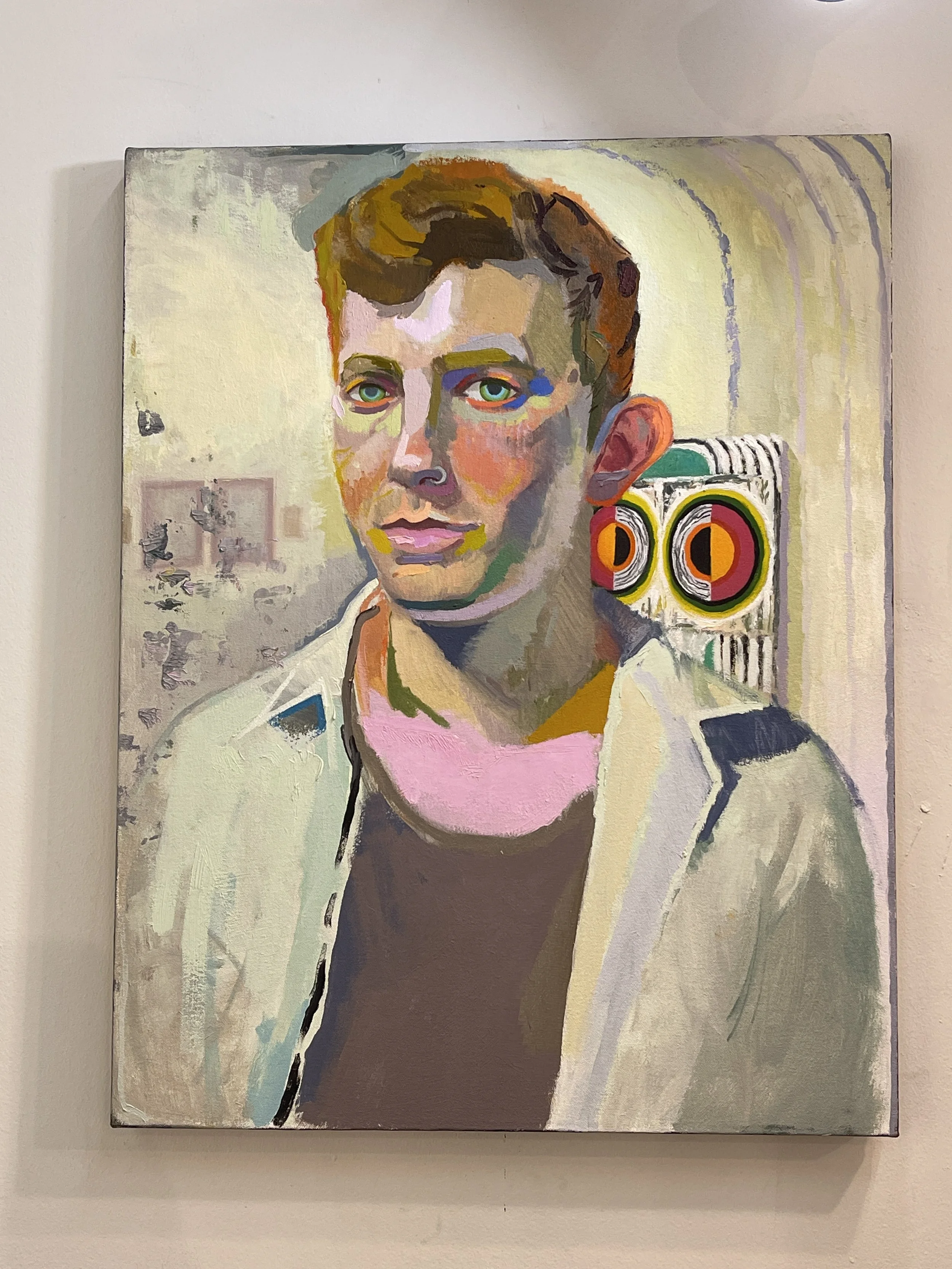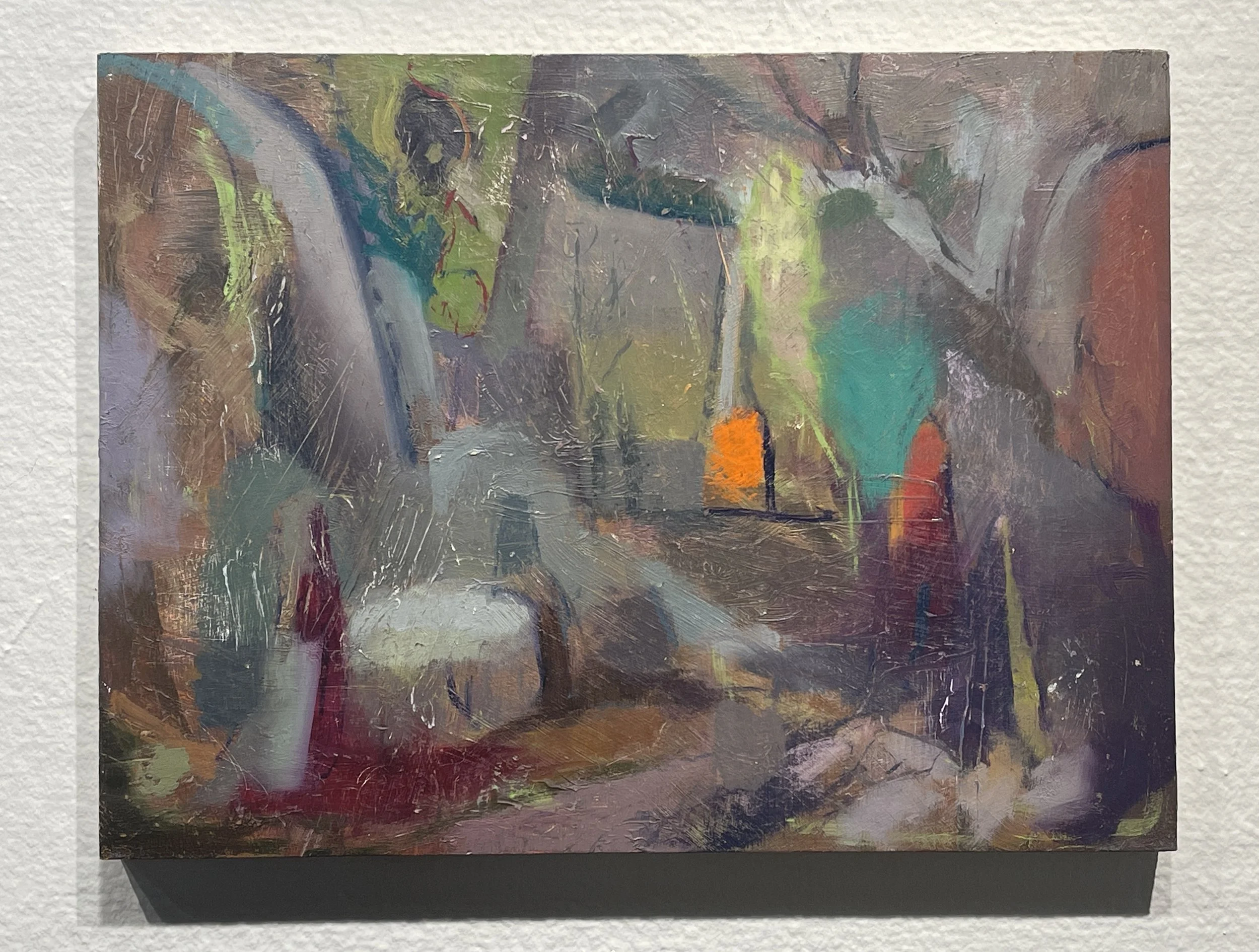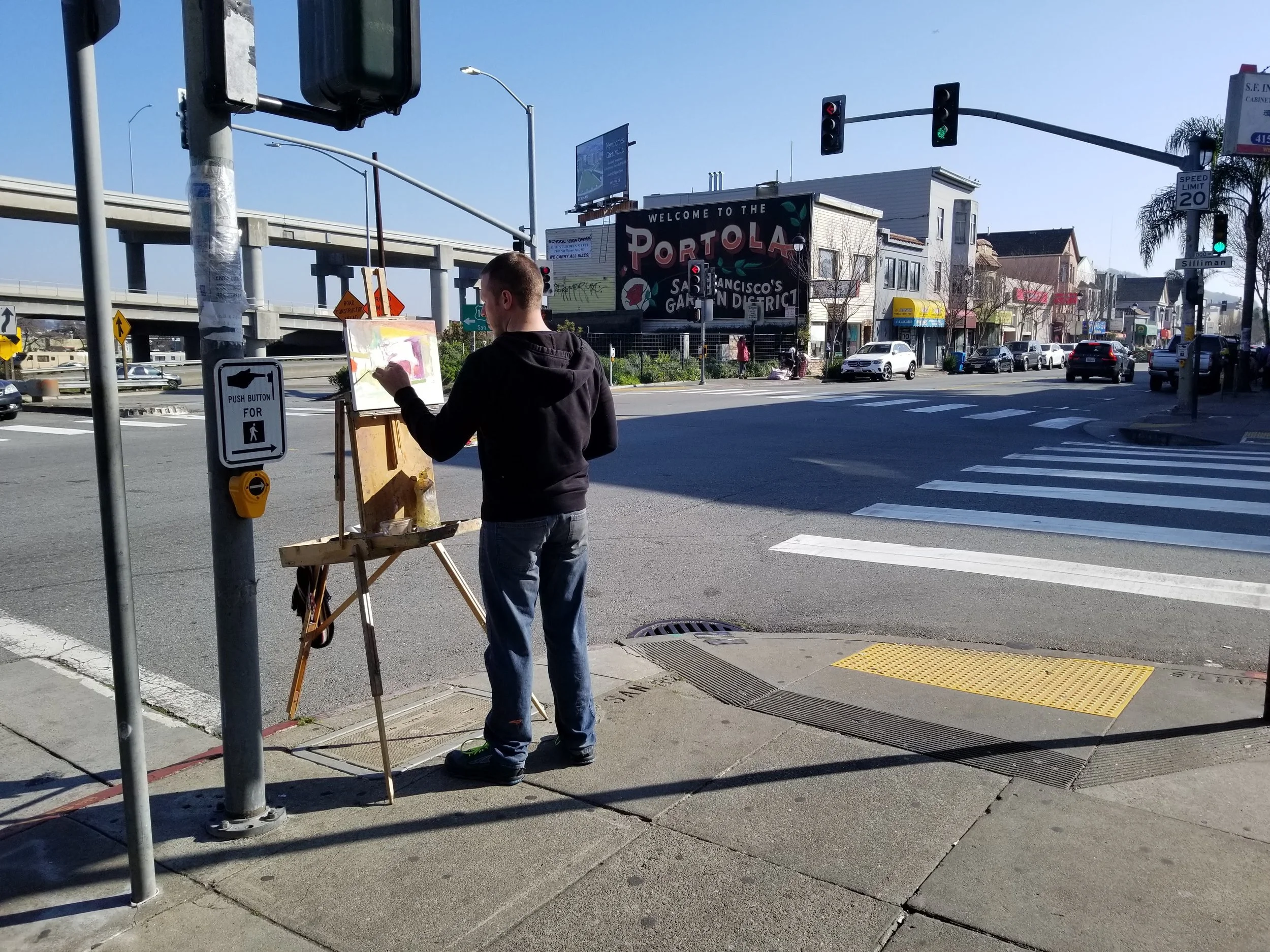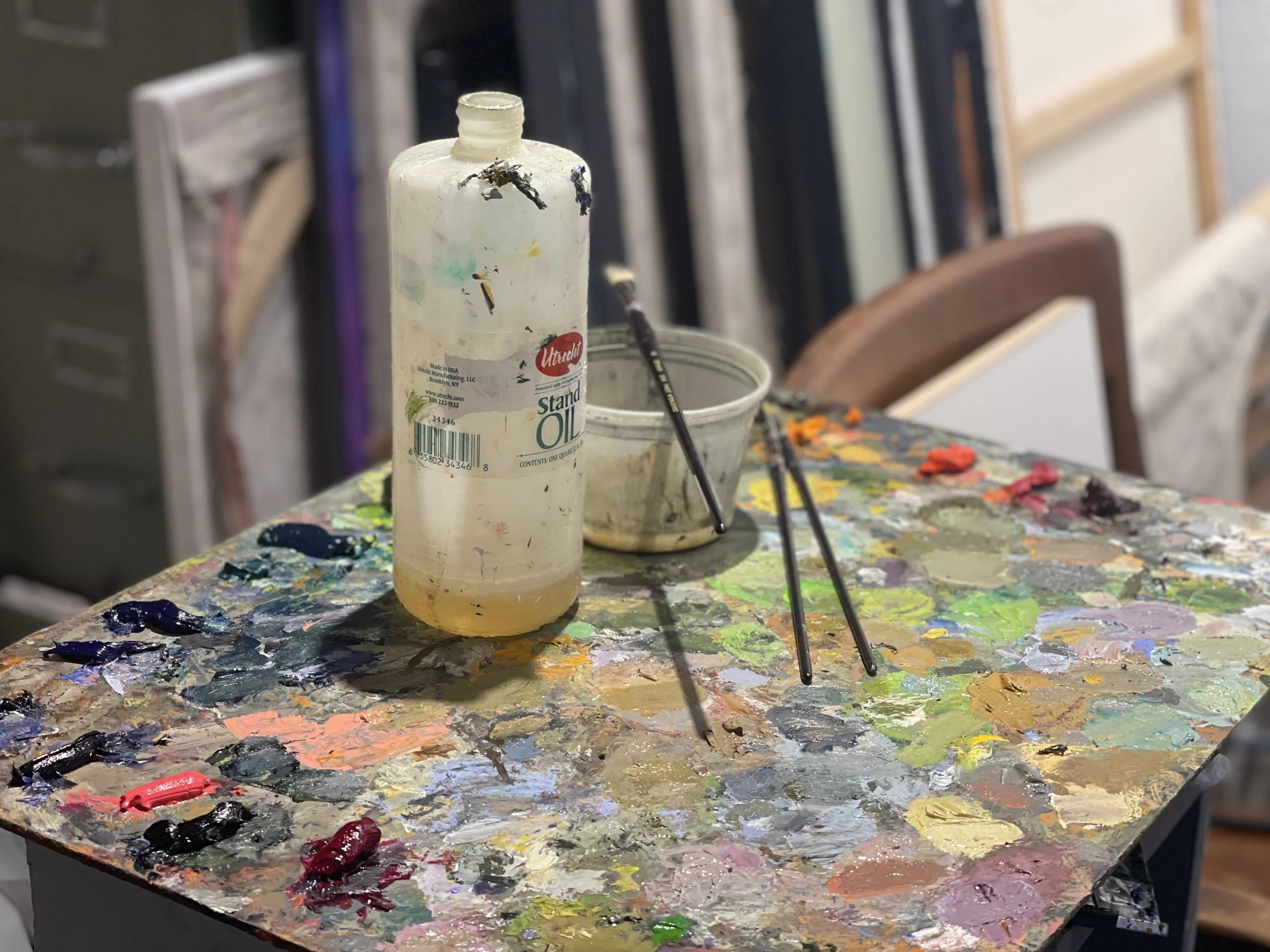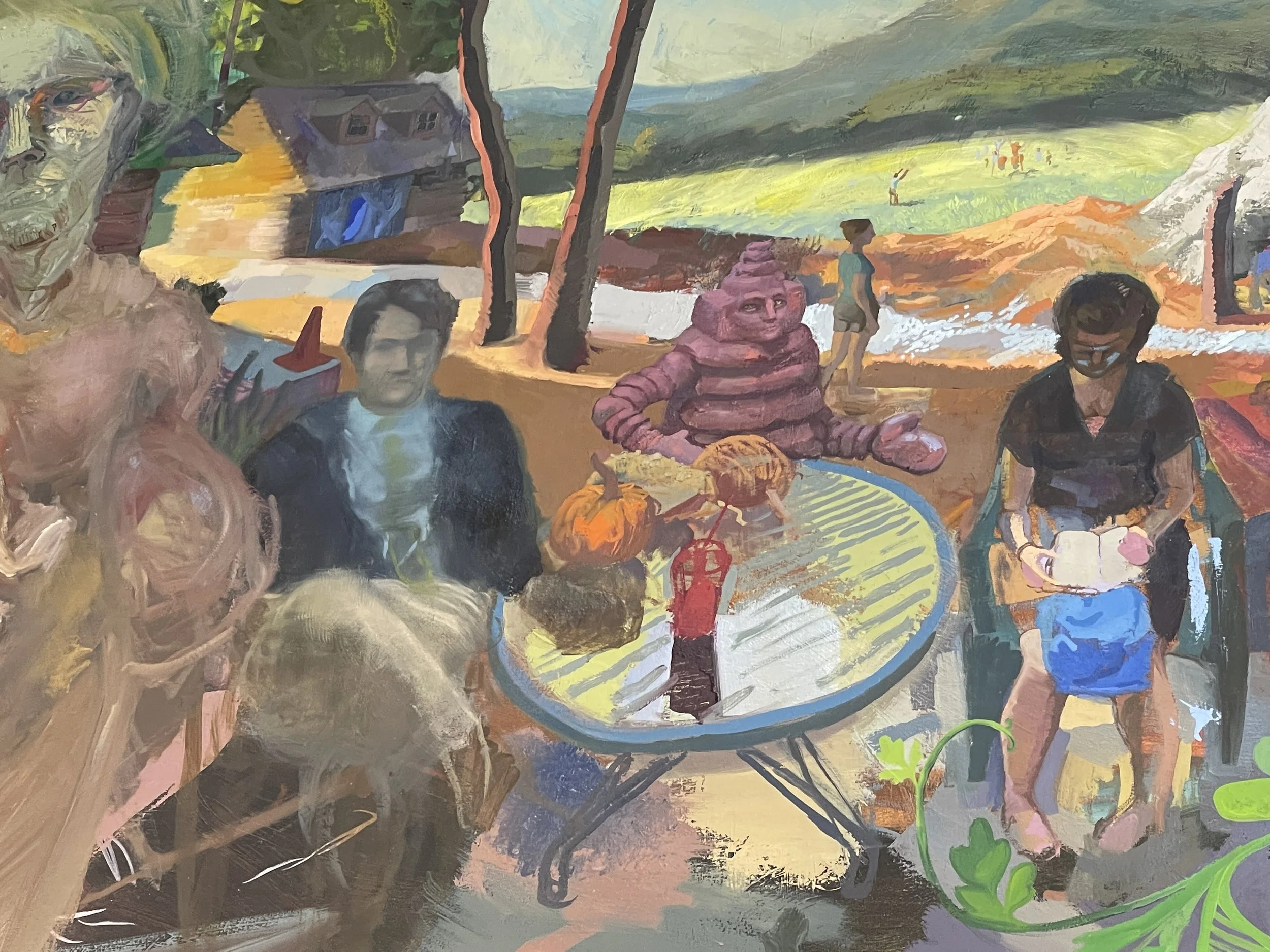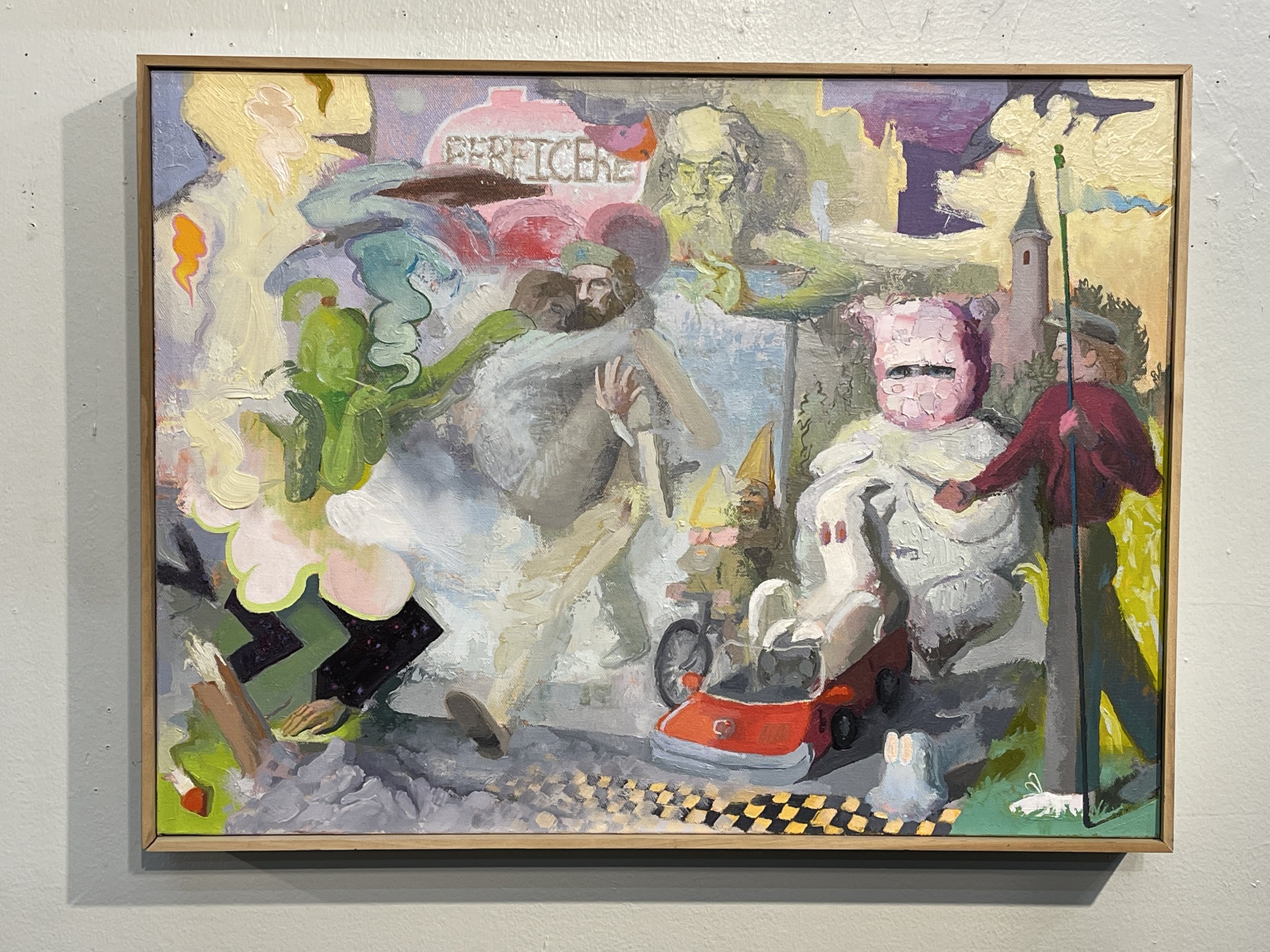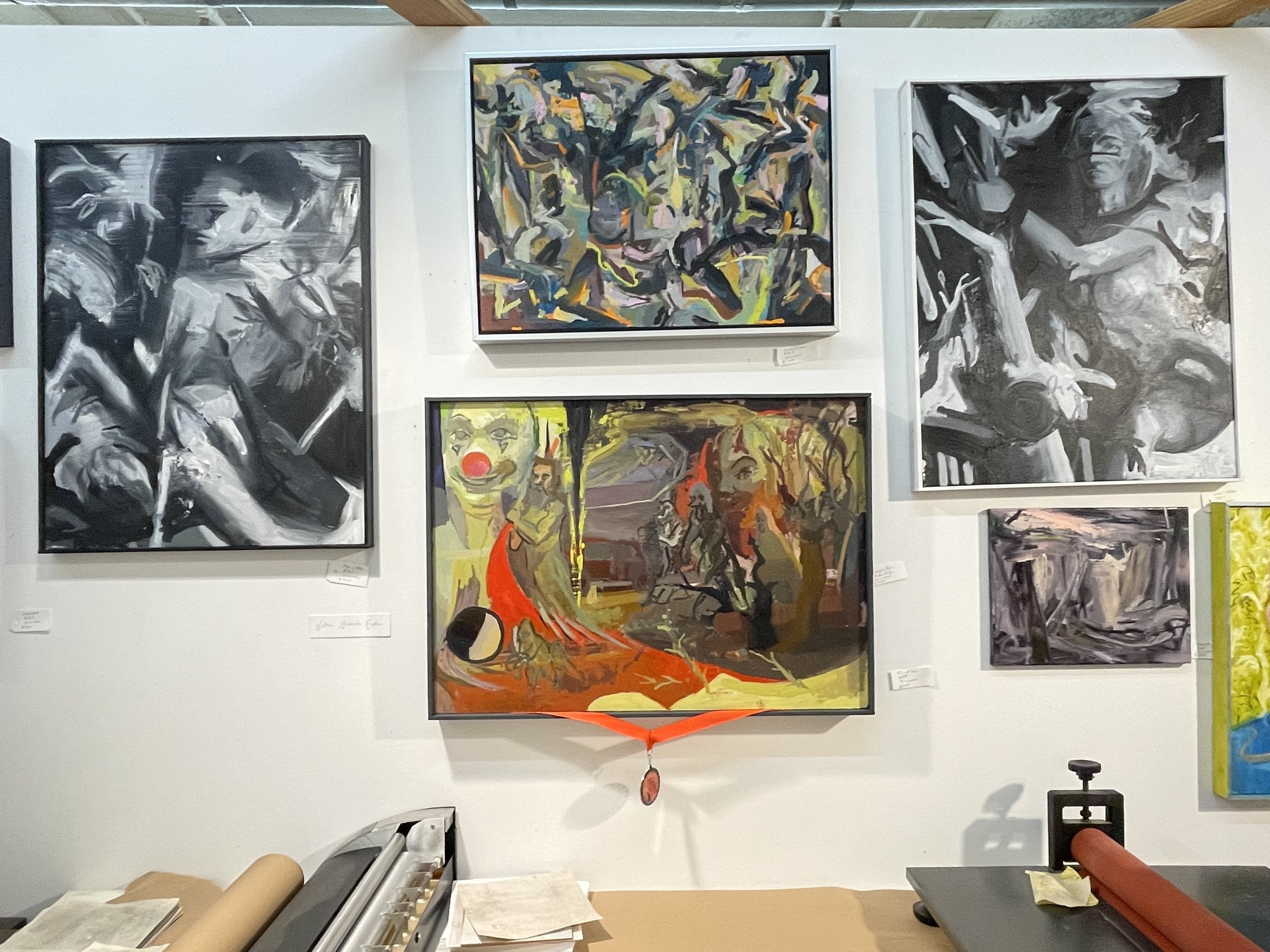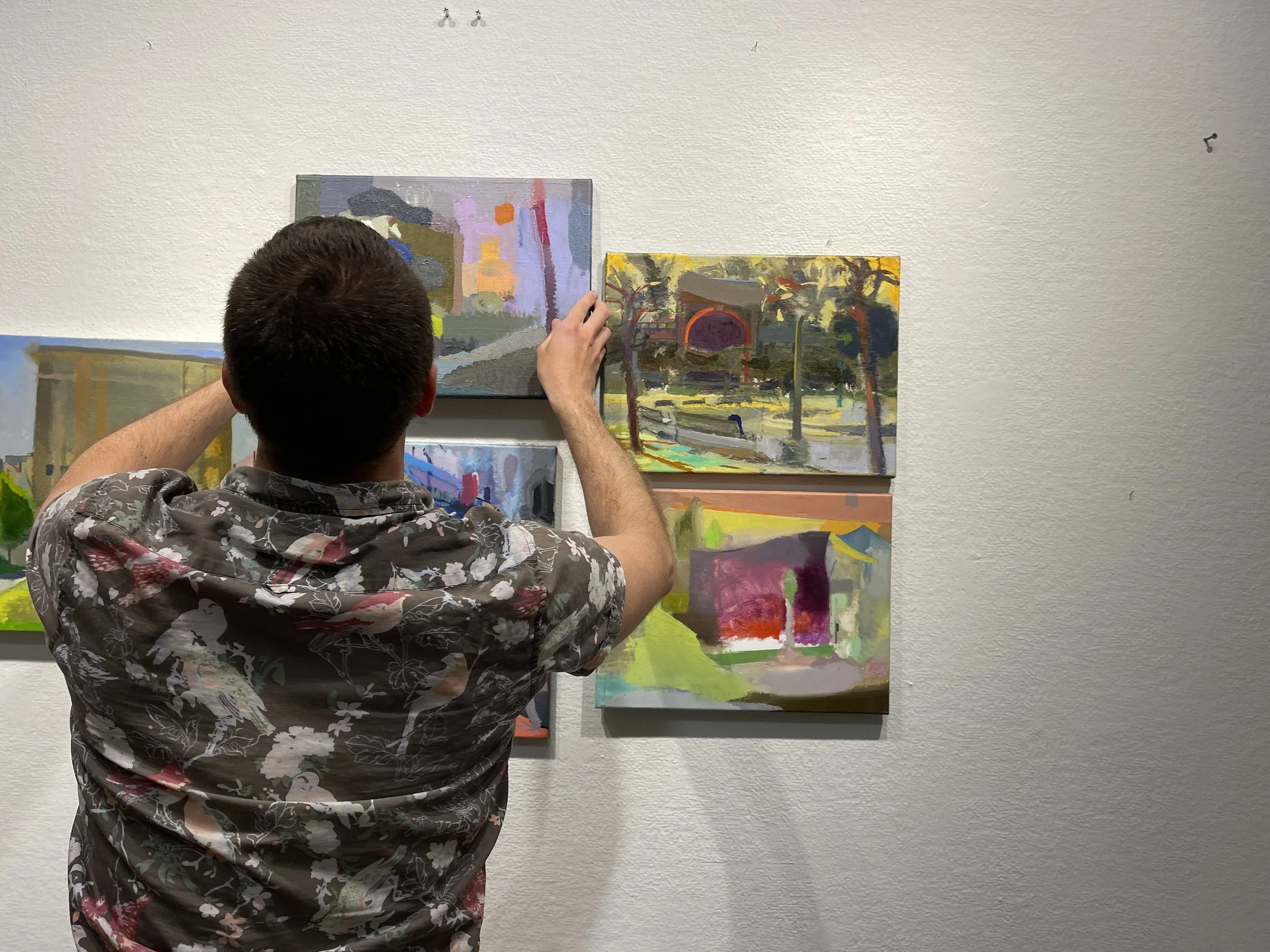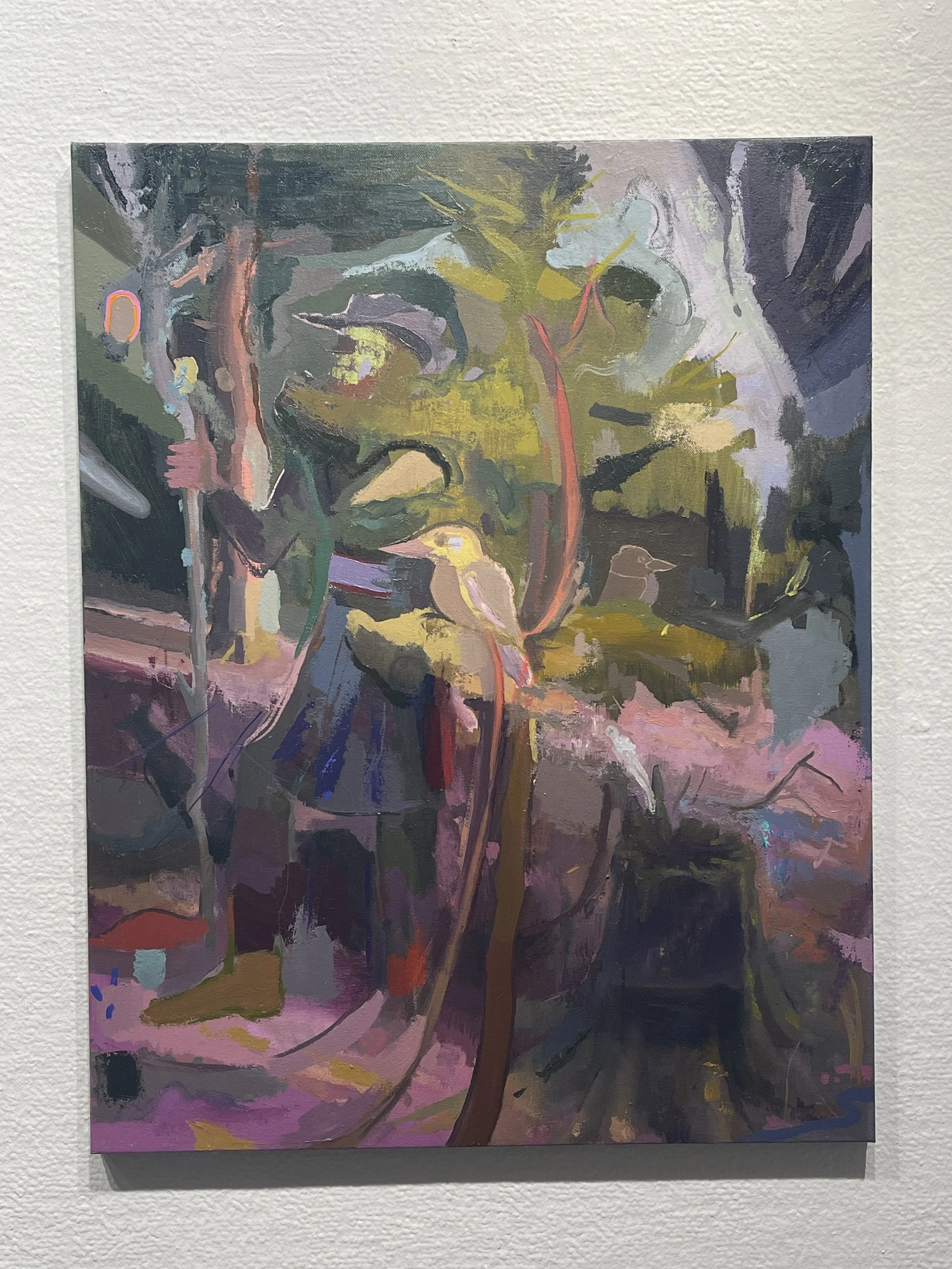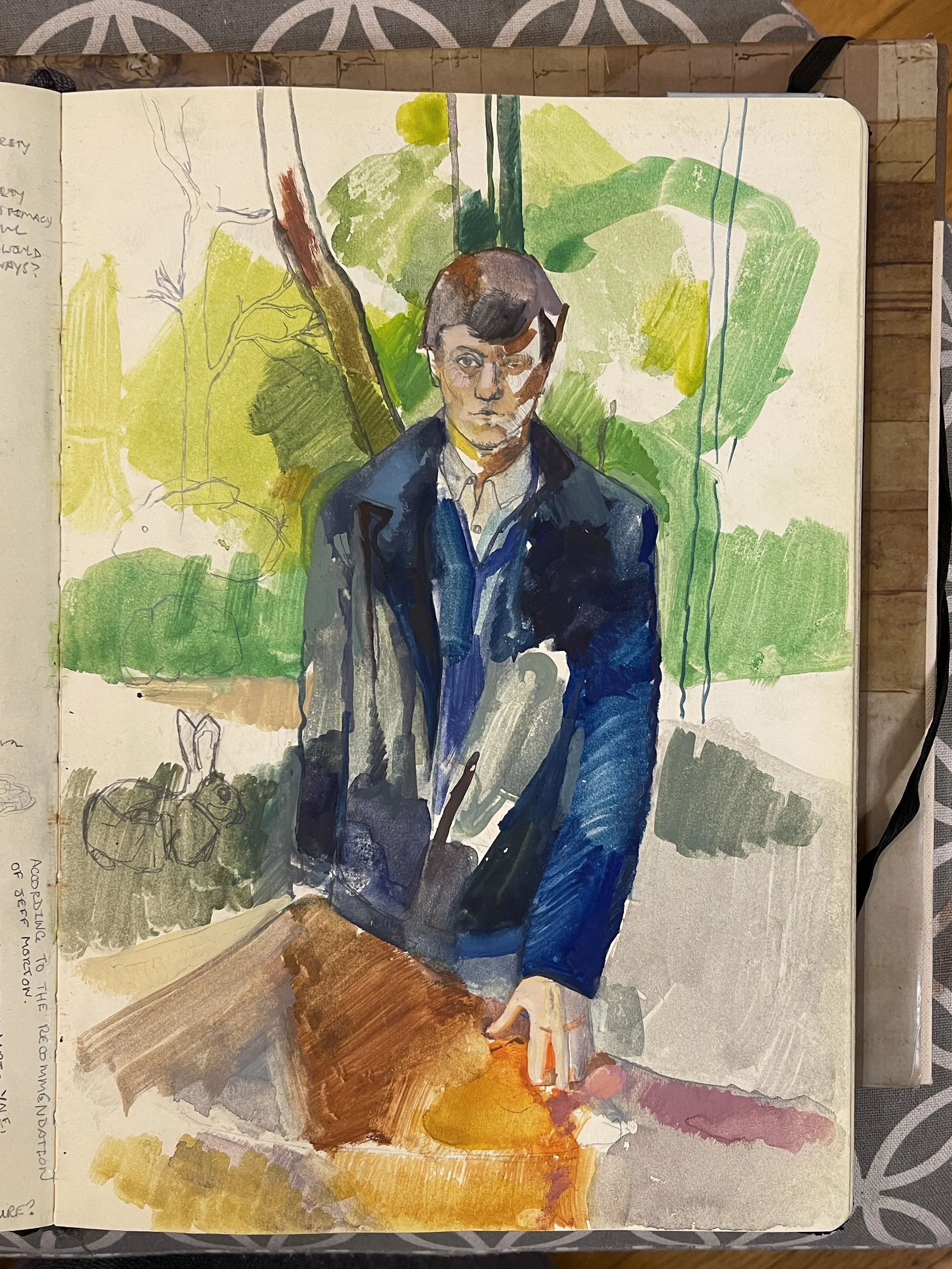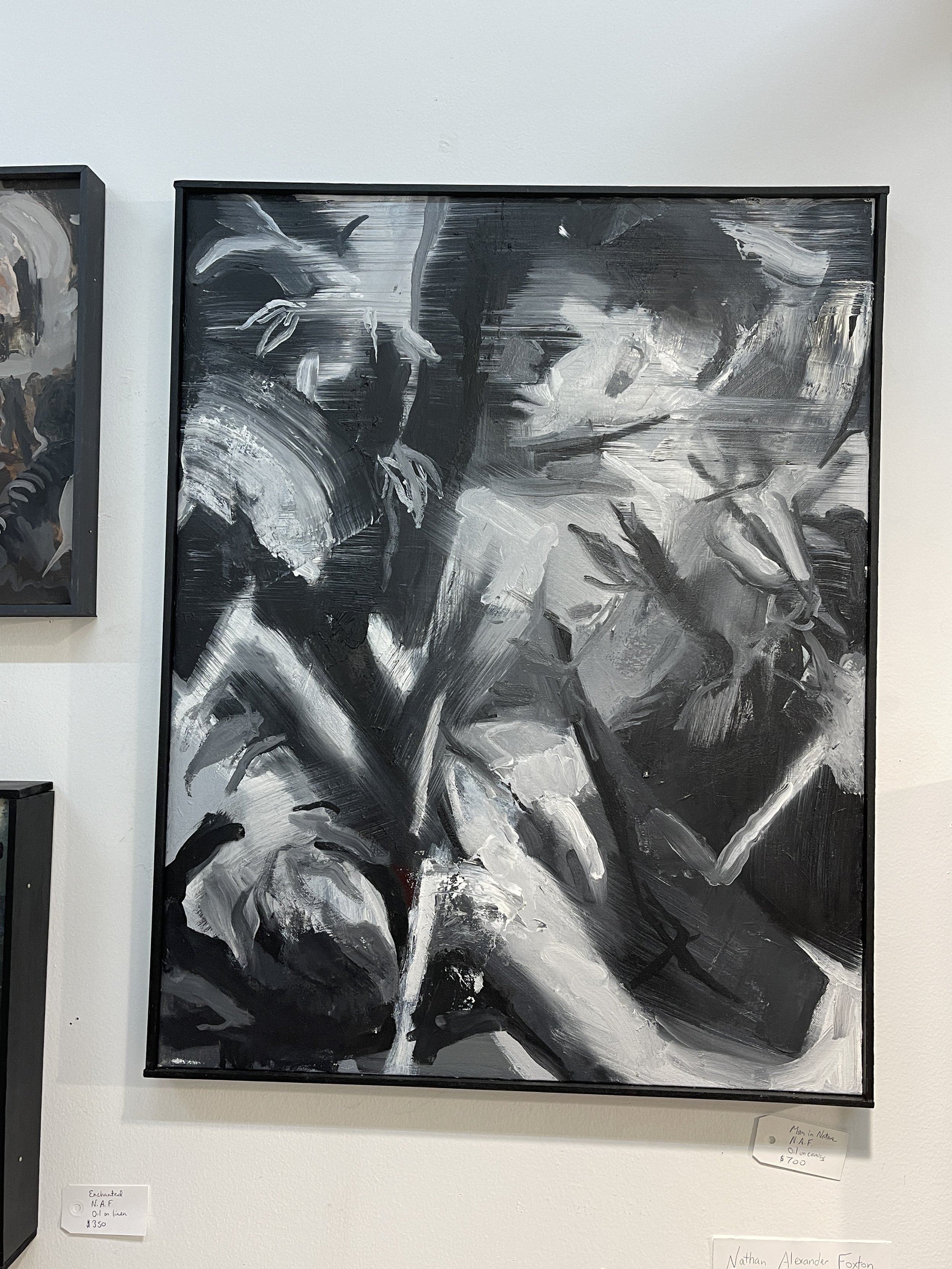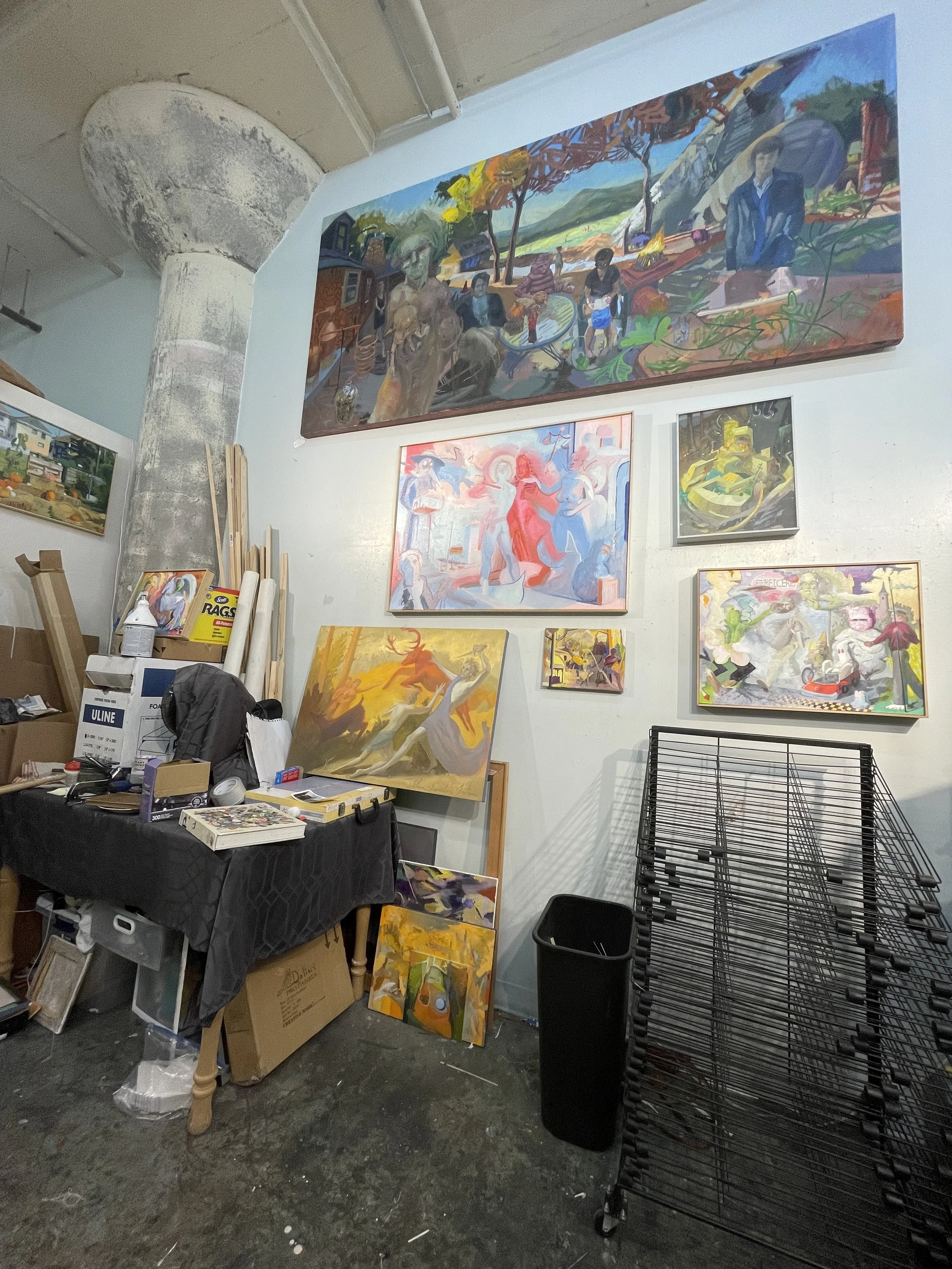Studio Visit & Interview with Nathan Alexander Foxton
By John Vochatzer
San Francisco has traditionally always been a magnetic city for artists, musicians, writers, performers, and every other type of creatives and outcasts you could imagine. When I first moved here in the early 2000s not only was it a mecca for such individuals, but it also seemed like almost everybody who was making any type of waves as an artist had some connection to this city; whether they lived here, had lived here at some point, exhibited here, or were just rooted in some way or another to SF and the Bay Area. Sadly, as many can attest to, with the arrival of the second tech boom of 2010s, the migration of artists to the Bay not only seemed to fall off all but entirely, but those that had prior called this city home gradually began to leave in droves. Some by choice and some by force. For the better part of a decade it seemed like the only type of people moving here were these 6-figure-earning Google employees who order everything they own on Amazon and never go anywhere or do anything. That was, until Covid-19. If there was any silver lining to the pandemic in San Francisco, it was that it drove some of those techie colonists outta here and finally started to bring down the notoriously exorbitant rents. In 2021, for the first time in 10 years, I noticed the artists and creatives were starting to finally come back. One such individual that I’ve had the great pleasure of meeting and getting to know is Nathan Alexander Foxton.
Originally from Rochester, New York, Nathan spent the last decade of his life living in various cities throughout the US while academically pursuing his ambitions as an artist. Most notably he spent several years in Indiana where he received his MFA in painting from Indiana University in Bloomington, and subsequently in Indianapolis where he worked as both a curator and an adjunct professor at Herron School of Art and Design. After a very brief stint in Chattanooga, TN, he finally landed in San Francisco in February of 2021. Fresh out of the chaos of 2020, it was a bold time to move to any city let alone the ever precarious Bay Area. After diligently working and developing his practice for years prior, as well as acquiring a slew of experience in the academic art world, the phase of Nathan we’ve received here now is a very well-rounded, and very developed phase to say the least. His work is complex, multidimensional, and topical, but all while still retaining a raw liveliness that combined make for a body of paintings that are as intriguing as they are powerful.
Splitting his art studio between his downtown apartment in The Tenderloin, and a shared workspace in The Mission District, I recently had the opportunity to visit both locations and get a peak into what Nathan has currently been working on. I also got an intimate look at the extensive collection of drawings and writings of his from over the years spent in other states that had travelled with him here to SF, and the foremost impression I’ve been given of Nathan is that of someone who creates passionately and even impulsively, with a dedication never wavering. In short, exactly the type of artists that give San Francisco the character and the dynamism that were starting to feel all but lost.
Interview
Hey Nathan! Thank you for letting me come check out your work spaces recently. It was a pleasure getting to see and learn more about your practice. Being relatively new to San Francisco, can you tell us a little bit about who you are, where you come from, and the art that you do?
I’m a person who is interested in the creative core of the individual, of people. I seek to develop creativity in myself and encourage it in others. I have diverse spiritual and psychological interests, with a curiosity as to how inner elements become clarified and actionable. I’m an artist, among other things.
I grew up in suburban, upstate NY where I had the relative freedom to explore and develop my art. Rochester has a rich history which I’ve appreciated more since leaving. My family immigrated there in the 1950s. The city was home to Susan B. Anthony and the Women’s Rights Movement, Fredrick Douglass and The North Star anti-slavery newspaper, and the country’s longest running student led LGBTQ newspaper. Rochester was the global center for optics and photographic processes during the 20th century. Half my family worked for Kodak at some point, and a couple of them helped design satellites. I think about the same time Rochester started losing its economic footing is about the same time San Francisco’s prospects started to sky rocket.
Growing up I was inspired by Ramon Santiago, a surrealist painter from Rochester. He had wide recognition in the city, and his artwork kept me intrigued about who he was. My dad had a print of his in his office and my uncle lived next to a house that had a more sensuous mural of Ramon’s in the upstairs hallway. I was able to observe his world, meet the people he worked with, and hear the stories behind his life.
I’m a figurative painter, I develop space as a 2-dimensional artist. Color is a primarily formal subject of mine. I’m interested in the logic of how the external world is represented, and I’m interested in the process of bringing one’s inner ideas to life. My practice is one where the journeys of my outer and inner world come together to reveal what is essentially me through paintings that have symbolic resonance.
I’ve been able to teach the areas of art I focus on in a university setting. I’ve guided many students through foundation courses while introducing them to artists, designers, organizations, and collectors. Building understanding and skills is a process. It's a great honor to scaffold the learning experience for people working towards their professional goals.
In a literary sense, I hope to be writing a story through my work about having perspective shifts, dismantling fear, creative problem solving, and having a life through art.
Having moved here a little over a year ago, I’d say it’s a bit of a tumultuous time to start over in a new city. What brought you here? And what are your initial impressions of SF and the art scene here?
It felt like the right moment to leave Indiana, and I was looking to move to a larger metro area. I had wanted to make a move in 2019 but had a couple big exhibitions that kept me there into 2020. I was living in this amazing old church designed by Kurt Vonnegut’s father and it was a world unto itself. I had my own art shows, dinner parties, slide talks and lectures for students. All that came to a grinding halt.
The church in Indianapolis converted into a living space and event space.
I’ve been making very gradual judgments about SF because I wasn’t here pre-pandemic, but I get hints from people.
SF is gorgeous because of its citizens that choose to share in community, its geography, and its spirit of experimentation and innovation. I’ve met quite a few people that didn’t feel like they fit in and SF welcomed them. I relate to that.
I observe there are a diverse range of art hubs here, where in smaller cities you don’t have as many options to connect. The initial encounter with the art scene was that there’s a plentiful amount of creative production and events that are offered publicly, but I think there’s also a considerable amount of latent creativity going on beneath the surface that doesn’t exactly have an outlet. I’m always looking for ways that creativity can make itself known.
Your painting studio is split between your apartment, and an actual shared workspace. How do these two different work environments compare and contrast for you? Do you allocate specific types of work to one or the other?
I enjoy working in both spaces, but for different reasons.
Some days between my other responsibilities I’d rather stay in and paint. We’ve really reconsidered what it means to work from home as a culture at large. I like being at my apartment! I can work on a painting and be the only person to see the piece. It’s easier to envision what it’s like to live with a work of art at home. My place has nice views, I can take late night snack breaks with two marts on my block, and I live biking or walking distance between *two* Blick stores.
1890 Bryant is a wonderful artist community with many great qualities. There are over 100 artists working out of independently run studios. I enjoy seeing my studio mates. They get me outside of my head, offer advice, and have introduced me to collectors and other artists. I sometimes work in the same space with @scabbyrobot, @judithklain, @robin.dick.art, @elsamadelinedesign, @sophiagreenart, and @jherren. I appreciate having creative professionals in the trench with me. The building hosts open studio events throughout the year and there’s a high bar for presentation. I value a semi-public platform to facilitate business from.
Part of it is the logistics. My apartment building was built in 1928, and has a narrow stairway and elevators. 1890 Bryant was originally a factory and now has many different size spaces. It’s easier to display larger work there.
One thing I like about a lot of your art is it has both an academic discipline as well an almost anarchic playfulness that seem to be in constant interaction with each other. Can you tell me a little bit about this dynamic in your work and where it developed from?
For me academic discipline as it currently exists is a dialogue between skillfulness and concept.
I study history to inform the dynamic of interaction in my work. Much of art in modernity is a story of the artist taking an active role in challenging preconceptions within a culture. I don’t think that is the only narrative you need to follow to make art worthy of notice, but you shouldn’t ignore it. We all have a conditioned sense of when things don’t line up, when concepts sitting next to each other visually or otherwise create tension. It’s whether or not you want to confront the tension for possibilities or go along with the prescription provided.
Because we live in a reasonably unbridled capitalist society, social movements…. Social communication is also commodifiable. This phenomena can be to the detriment of being able to weigh observed input and the message deduced from it. People in the US give up the responsibility to weigh situations reasonably all the time. It’s why Fox News can sell its viewers an image of San Francisco as a horrible place to be, and why Pepsi tried to profit from the riots in 2020 with Kylie Jenner. We need to question what we see.
I believe artists should be strong independent creators in relation to the ebbs and flows of culture. Concerning my anarchic playfulness, the dynamic in my work comes from questioning cultural positions and technical positions. The play in my work is finding resonance and truth.
Viewing and acquiring work from an artist gives an opportunity to commune with a perspective that has weighed the input and irrational/subconscious impulse in a grounded expression. Anarchic playfulness is part of the job of a socially responsible artist.
Another reoccurring element I saw in many of your paintings was the juxtaposing or collaging of multiple locations or multiple narratives into one. There’s something very fluid and even dreamlike about this quality to your work. I’m curious about the intentions behind this. Do dreams or dream logic play any role in your creative process?
Yes, dream logic plays a role in my creative process.
Your sense of being has roots in the subconscious. That part of your brain is loosely following along to the structure and logic of language, but is helping you make sense of the world. During the last few years I’ve been studying and dialoguing about the subconscious, intuitive process, and forms of surrealism.
I’ve been resistant to the surrealism label because of some of the things Peter Schjeldahl brings up in his criticism.
I believe artists have the capacity to have a productive relationship with the subconscious. My life has been full of change, and I’ve found spiritual centering to be incredibly helpful. Part of that centering has been releasing fear of interacting with the subconscious. Our conscious mind gravitates to the beauty of logical structure, and the systems in our world provide a plethora of structure. We have an obligation to build some part of our identity in relation to that outer structure, but I think we miss something if we close ourselves off from the millions of years of evolution that have accumulated in our minds. We have an inner responsibility to reconcile light and shadow within and how that manifests outwardly. I say that with much humility.
You’ve been doing a lot of plein air painting here since you moved to San Francisco as a way of familiarizing yourself with a new city and home. How has that been going? Have you learned anything or had anything revealed to you about this new environment and your relation to it?
Nathan painting at the intersection of Silliman Street & San Bruno Ave in San Francisco
Its been a positive experience, people I’ve encountered have responded well! The way I paint involves developing a relationship with a place. The experience is like finding out what time of day you like to be in a certain neighborhood.
Before San Francisco, you had lived in various other cities including Bloomington, Indianapolis, Chattanooga, and Rochester, NY where you are originally from. How would you so far compare San Francisco to these other places?
San Francisco has a lot of breathtaking, unique qualities. I think every place has something to celebrate, if people are able to rally. Some places don’t realize what they have, which is why I think traveling is important. Each of the places I’ve lived have allowed a part of me to grow, and I feel that San Francisco is an optimal place to develop.
San Francisco has extremes, and many eddies where individual dreams are manifesting. Because of all that energy happening here, it creates pressure. That can be both a good and bad thing. There are many beautiful places in the US where you can have a good life without the level of pressure that’s here, but there's also fewer opportunities.
Apart from being an artist, it was interesting to learn about your curatorial endeavors while you were living in Indiana. Can you tell us a little bit about the work you did as a curator? What kind of art did you put emphasis on? And what kind of work currently has your attention?
I saw curating as a way to explore artistic practice, build community, and sell work! In part because of teaching at Herron School of Art + Design in Indianapolis, I valued ‘process’ highly.
In the exhibition Summer Landscape curated in 2016 I asked a group of artists to take a smaller plein air work and turn it into a larger painting, at least 4’x4’ in square footage. I wasn’t looking for a uniformity of style, I was asking the participating artists to engage in creative problem solving. Indiana has a range of artists working from observation, and I wanted to inquire, “What if we take this farther, what is your process?” We filled two gallery spaces! Here are a couple interviews I facilitated for the show with Carla Knopp and Ben Lowery.
From the exhibit “Tuning Inception” at Harrison Gallery in Indianapolis.
In Tuning Inception I identified artists who incorporated cartoon conventions into their process. I was looking for the kind of abstract meditation they allowed. Because of the non-profit context of where I was curating, I brought together both students who were just getting their foot in the door and established artists. That was a really bold show to put together where I displayed the work of @coreylamb, @alyssadaytattoos, @junk__lord, @snodster, and @planetjunk, among others.
The curator in me gives attention to compelling ideas that I can get people to gather around. Part of that is knowing what artists are focusing on while they work. We live in a turbulent time, and artists are making work in relation to the issues shaping our lives. Political discourse can be crippling, but there's nobody more qualified to take terrifying, ambiguous information and turn it into expressions worthy of meditation than an artist. The role of curator helps bring the conversation an artist is having to light.
You’re also an avid writer and even mentioned often being torn between being a writer and a painter. Can you compare and contrast these two types of expression for you?
Painting and writing have a way of illuminating how we exist in the world. In the best instances, I’m able to flow from one to the other. The two activities represent two different modes of being while they’re from the same mind. When I write, it's about an exactitude. Language is incredibly powerful and precise, a concentrated form of communication and experience. I enjoy poetry, I enjoy ambiguous writing but those forms are not primarily how I use language.
Painting has a way of bringing awareness to the meaning between the things we label, all the experiencing when we’re not using words. A significant portion of our brain is for visual processing. It's not that we can’t apply words to experiences, but that sometimes the primary mode of existence is non-linguistic.
Moving between writing and painting is about a shifting of experience between the known and the unknown.
More often than not, the two expressions are supporting each other in my practice. I believe one of my goals as an artist is to inhabit more spaces where these expressions can breathe.
This interview has been a great opportunity to find that space, thank you!
Over the past year you’ve taken a little bit of a step away from sharing art and putting yourself out there as an artist, but all the while still working diligently on new paintings and series’. Would you say you’re on the verge of a reemergence? And what can we expect that to look like when it happens?
I’ll be reemerging with new work on @psychic_chroma and www.nathanfoxton.com before the end of the month.
The paintings I’ll be releasing could be divided into three groups. The first represents the liminal space between the external world of SF and my inner life. The second group are more straightforward observational works showing my followers around the bay area. The third will be paintings I haven't released before, some will be available at accessible price points on @luxelobby.
